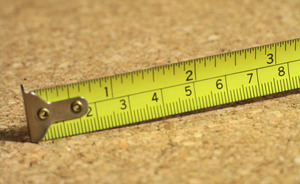The longer I work as a handyman, the less I want to be getting up and down from the floor any more than necessary. Door trim and baseboard can be a killer on the knees and back at any age. Try a few of the following tips and tricks to relieve the strain on your body and mind, as well as complete a better project. Any do-it-yourself homeowner can use these ideas to good advantage.
Whether you are painting your trim or giving it a nice stain and polyurethane finish for protection, break out the sawhorses before doing anything else. Adjust them to a good work height and lay out your unfinished and uncut trim facing up.
If painting, fill and sand any defects, then prime each piece with a good quality spray-on or brush-on primer. Sometimes this will slightly raise the grain, so be prepared to do a very light sanding before applying a final coat of paint – just enough to knock down the “fuzz” from open grain areas.
If staining your materials, apply the finish as directed, filling any holes or nicks in the wood per directions of the filler you prefer. If you use a quick-dry filler, sometimes it’s best to fill holes after the stain and/or protective finish is applied to keep it from working into the raw wood grain. Wood fillers often take up stain differently than bare wood despite manufacturing label claims. Try a sample area on the back of your material first to see if it gives the results you want.
After your trim pieces are completely dry, get out your miter box and saw, or rent a cutoff saw. If you’ve never used a cutoff saw it’s essential that you practice on a few scraps or end pieces before proceeding. As always, use eye and ear protection. Never use your fingers to brush away sawdust or debris from a spinning or jammed saw blade.
Along with your choice of saw you should have a tri-square, a 20 or 25 foot tape measure, a good hammer (one that has a good feel to the grip and balance in your hand), a nail set, 6d and a few 8d finish nails, and a small hand held or table top belt sander.
Start by cutting your longest pieces first. Remember to measure to the appropriate inside or outside corners and also remember which side of the line your saw blade should cut on. Allowing for blade thickness can save the DIY homeowner much frustration and grumbling. If you make a mistake and cut something short, you can use it on a smaller section of wall.
I like to secure each piece to the wall as I cut. That way you have a solid piece to work against when mating corners or mid-wall splices to it. Use your 6d nails when you can (use 8d when you have to), remembering that you may have to angle them downward slightly to hit the lower 2 x 4 wall plate, especially if you are trimming on top of a plush carpet or on a full thickness wood flooring. You can set the nail heads below the surface at this point, or do them all later before filling and touch-up.
When mating corners and splices, keep the belt sander handy, or a coarse wood rasp for undercutting the back side angled cuts that don’t quite match due to a thick buildup of joint compound or unsquare corners where walls meet. (Corners are rarely square.) If you’re fitting an inside corner, try shaving a little off of the long point to allow for a joint compound or paint build up. Don’t be afraid to sand some thickness off of the back side of your trim to make it fit at the corners. Do what it takes to make the joint fit well.
Very small pieces of trim are sometimes hard to nail without splitting them. Do one of two things. Either pre-drill a small hole the size of the nails you are using, or apply a caulk such as construction adhesive to secure it to the wall. If pre-drilling, allow for the extra thickness of the nail head. When setting a nail head below the wood surface, an undersize hole can sometimes force the grain to split. It’s also best to pre-drill nail holes less than three inches from the end of your trim to avoid splitting.
If you are installing painted trim and want to minimize any open areas on your corner work, then I suggest applying a small bead of paintable caulk on the mating surfaces before nailing the boards in place. Keep a damp rag handy to clean off what squeezes out of the joints as you secure them together. Believe me, it’s a lot easier to do it this way than try to squeeze caulk or spackle into a sixteenth inch corner crack. Depending on the color, you can do the same thing with a matching caulk for stained trim. If you can’t find the right color in paintable caulk, try looking in the wood flooring section of your DIY store and choose a floor crack filler that is colored close to what you are installing. Most of these floor fillers also clean up with a damp rag.
After the cutting, fitting, adjusting, caulking, nailing, and nail setting, . . . all you need to do is fill a few nail holes and touch up the stain or paint. Don’t forget the corner touch-ups. For filling nail holes, I like to use one of the fast drying, no-shrink spackle compounds available at any hardware or home center. Apply it with your finger by pushing it firmly into the hole, then lightly rub away the excess until it is level with the surface. Done! By the time you get around the entire room, it’s usually ready for paint. If you glop too much in one place, most of these fillers are easily sanded with a fine grit paper.
For stained surfaces, use a nail putty available in your favorite DIY store. Often a dry rag helps to smooth over these fills. Wrap the rag around your finger, and using moderate pressure combined with several quick back and forth movements, wipe away the excess filler. Sometimes if I’m only working on a few holes, I use one finger to apply the filler, and a clean finger to wipe away the excess. In either case, keep a rag close for cleaning woodwork and fingers.
Well done handyman. Put your tools away, change your clothes, and take the wife out for a celebration dinner.




